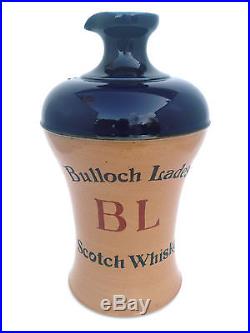
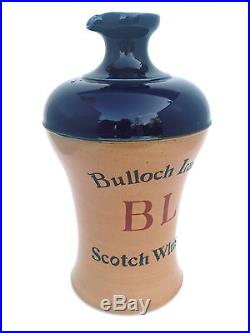
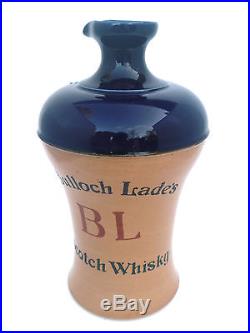
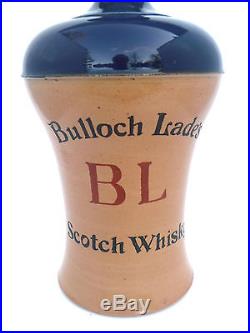
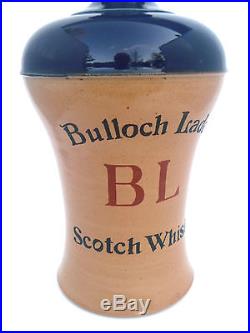

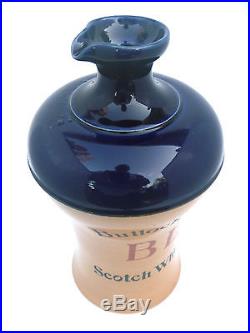
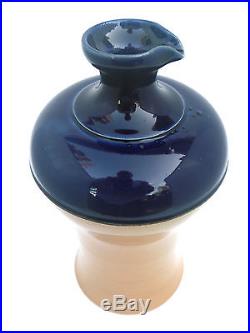
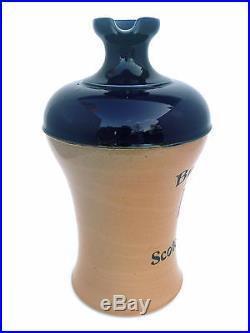
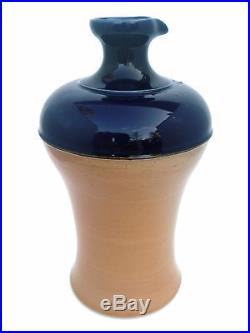
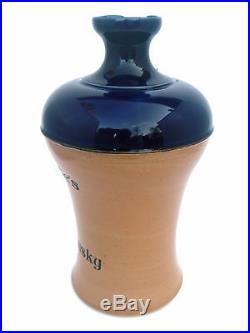
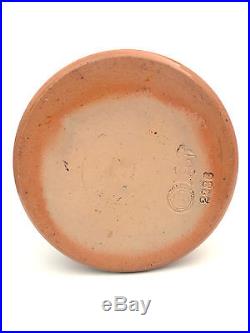

Welcome To Yorkginger’s e B a y Store Sale! THIS SALE IS FOR A ROYAL DOULTON BULLOCK LADE’S BL SCOTCH WHISKEY WHISKY QUARTER GALLON STONEWARE JUG ONLY! THE JUG MEASURES 8 1/2 INCHES TALL AND DATES AROUND 1920’S. POTTER’S MARK ON THE BOTTOM READS” ROYAL DOULTON ENGLAND” WITH THE LION OVER CROWN ROYAL DOULTON MARK. THIS ROYAL DOULTON BULLOCK LADE’S BL SCOTCH WHISKEY WHISKY STONEWARE JUG IS IN EXCELLENT CONDITION WITH NO CHIPS, CRACKS OR RESTORATIONS. PLEASE CHECK ALL PHOTO’S FOR FURTHER CONDITION. José Roberto Briguenti’s Largest Whisky Collection in The World! Atualmente a versão Mobile de nosso website está em fase de desenvolvimento, mas você pode conhecer a coleção através dos links abaixo. Currently the mobile version of our website is under development, but you can know the collection through the links below. Catedral do Whisky maior coleção de whisky do Brasil.. A repórter Rebeca Grisi do Programa Amaury Jr. Mostra a maior coleção de whisky do Brasil. Localizada em Itatiba/SP, a Catedral do Whisky é um verdadeiro tem.. The reporter Rebeca Grisi Amaury Jr. Program displays the largest collection of whiskeys in Brazil. Located in Itatiba / SP, the Whisky Cathedral is a true must.. Catedral do Whisky é uma das maiores coleções de Whisky do mundo com aproximadamente 18.700 Garrafas. Whisky cathedral is one of the largest collections of whiskey in the world with approximately 18,700 bottles. PLEASE CHECK ALL PHOTOS BELOW! Check out my other items. John Doulton married Jane Duneau, a widow from Bridgnorth in Shropshire, who died April 9, 1841. They had eight children, including Sir Henry, Bob MP, Josiah and Alfred. Her foreman, John Watts, was also taken into partnership and the firm became known as Jones, Watts and Doulton. It specialized in industrial ware, brown stoneware, drain pipes as well as stoneware bottles for chemicals, beer, and other industrial liquids among others. Martha Jones withdrew from the partnership in 1820 and the company moved to new premises in Lambeth High Street in 1826. In 1835 John’s 15 year old son Henry Doulton was taken on as an apprentice. By 1846, Henry had set up an independent Lambeth Pottery which had become the leader in industrial products, particularly sanitation products. Following the retirement of John Watts in 1853, Doulton and Watts merged with Henry’s company to become Doulton and Company and was highly recognized for its lines of hand decorated figurines, vases and dinnerware. His brother, Frederick Doulton, became Member of Parliament for Lambeth from 1862 until 1868. His father had become a partner in a pottery business in 1815 but Henry was the most academic of his children. Henry spent two years at the University College School where he developed a love of literature. His father had thought Henry the least likely to join the family business, perhaps being destined for a profession, but in 1835, he joined the firm, as did all his brothers other than Frederick. One of the first results of his many experiments was the production of good enamel glazes. In 1846 he initiated in Lambeth the pipe works, in which he superintended the manufacture of the drainage and sanitary appliances which have helped to make the firm of Doulton famous. In 1870 the manufacture of “Art pottery” was begun at Lambeth, using the skills of students from the Lambeth School of Art (later the City and Guilds of London Art School). The company exhibited at the Centennial Exposition of 1876 in Philadelphia. In 1877 works were opened at Burslem, where almost every variety of porcelain and earthenware has been produced. Works have since been opened at Rowley Regis, Smethwick, St Helens, Paisley and Paris[citation needed]. After the Paris exhibition of 1878, Henry Doulton was made a Chevalier of the Légion d’honneur. In 1872 the Art department was instituted in the Doulton works, giving employment to both male and female artists, among whom such workers as George Tinworth and Misses Hannah and Florence Barlow obtained a reputation outside their immediate sphere. In 1887 Henry Doulton received the honor of a knighthood, and a few years later was awarded the Albert Medal by the Royal Society of Arts. In 1849 he married Sarah, the daughter of Elizabeth and James Lewis Kennaby. They had three children, Sarah Lillian (1852-), Henry Lewis (18531930), and Katherine Duneau (18561932). His wife Sarah died in 1888. Sir Henry Doulton took an active interest, as almoner, in St Thomas’ Hospital. Appropriately after his death in London, he was placed in a mausoleum at West Norwood Cemetery constructed from red pottery tiles and bricks from the Doulton Works, which is now a Grade II Listed building. Doulton and Co, of Royal Doulton Potteries, Burslem, Stoke-on-Trent, Staffordshire. Of Royal Doulton Potteries, High Street, Lambeth, London, SE1; and Nile Street, Burslem, Stoke-on-Trent, Staffordshire. Telephone: London – Reliance 1241; Burslem – Hanley 7266. Cables: “Doultons, London”; “Doultons, Burslem”. The Doulton Company produced tableware and collectables, with a history dating back to 1815. Operating originally in London, its reputation developed when it moved to The Potteries, where it was a relative latecomer compared with other leading names such as Spode, Wedgwood and Mintons. Today, its products include dinnerware, giftware, cookware, porcelain, glassware, collectables, jewellery, linens, curtains, and lighting, among other items. Its three key brands are Royal Doulton, Royal Albert, and Minton. Together, the three brands make up Doulton Home, which is now part of the Waterford Wedgwood group. Most of the pieces in these three brands are manufactured outside the United Kingdom, in the Far East and Indonesia. 1815 John Doulton (17931873) became a partner in the pottery of Martha Jones in Vauxhall Walk, London, together with John Watts. The business became Jones, Watts and Doulton. It specialised in making stoneware articles, such as decorative bottles and salt glaze sewer pipes. 1820 Mrs Jones withdrew from the business. 1826 Doulton and Watts flourished, moving in 1826 to premises in Lambeth High Street. 1834 Doulton and Watts establishment at High St, Lambeth involved 12 men working 2 kilns per week. Eventually 6 of John’s sons joined the business including John junior (the eldest) and Henry who became an apprentice in 1835. Henry was to be the driving force behind a number of innovations which made the name of Doulton world famous. 1846 Henry Doulton left home to start his own business to make ceramic pipes for the sanitary market. In addition Henry continued to help his father’s firm of Doulton and Watts, and both concerns gradually expanded onto adjoining land and premises. 1853 John Watts retired. 1853 Doulton and Co was established by John and his son Henry as makers of fine English stoneware. 1855 Partnership dissolved: Doulton and Watts, potters, High St, Lambeth. At some point the 3 businesses of Doulton and Watts, Henry Doulton and Co and the independent pipe works owned by Henry’s brother, John Doulton junior, were brought together. 1857 John Sparkes, principal of the Lambeth School of Art, approached Henry Doulton with the idea of producing artistic ware. While the functional pottery business was so successful, there was little incentive to develop new product lines. Eventually Sparkes and Edward Cresy, an engineer and lifelong friend of Henry Doulton, convinced him to experiment with artistic designs. Much work was needed to solve the problems of making artware. 1862 Doulton and Watts demonstrated a potter’s wheel at the International Exhibition. 1867 Henry Doulton presented the first examples of his art pottery at the Paris Exhibition. 1870 Doulton’s technical problems with artware were finally solved. By 1871, Henry Doulton had launched a studio at the Lambeth pottery, and offered work to designers and artists from a local art school. Their names included the Barlow family (Florence, Hannah, and Arthur), Frank Butler, Mark Marshall, Eliza Simmance, and George Tinworth. 1873 John Doulton senior died. By this time, the firm was an established leader in industrial ceramics, and was just entering the field of art pottery. The revival by Doulton and Co of the salt glaze stoneware that came to be known as Doulton Ware was one of the major triumphs of the firm. From small beginning, the staff of artists and decorators (including such well-known names as George Tinworth and Hannah Barlow) rose to 345 by 1890. 1876 John Duneau Doulton registered the company’s first trademarks. 1877/8 Doulton bought a small factory from Pinder, Bourne and Co at Nile Street in Burslem, Stoke-on-Trent, Staffordshire. Doulton became increasingly popular, thanks mainly to the artistic direction of John Slater, who worked across a wide variety of figurines, vases, character jugs, and decorative pieces. The company was soon producing bone china at this factory. 1882 The name of the Burslem works was changed from Pinder, Bourne and Co to Doulton and Co Ltd. 1882 A new building was added to the High Street Pottery to cope with the demand for artware, which took numerous medals and prizes. This success was matched by growth in the Staffordshire potteries. The knighthood conferred on Henry Doulton in 1887 was a recognition of his outstanding achievements. 1889 The Lambeth establishment employed c. 2000 people and there were another 2000 employees in other parts of the Doulton empire; drain pipe works were also at St Helens and Rowley Regis. 1891 Doulton and Watts, encaustic tile makers, filter makers and crucible makers, 28 High St, Lambeth. Doulton and Co was at Albert Embankment. 1891 Henry Lewis Doulton became a partner. 1895 Doulton and Watts, Lambeth Pottery, London SE, manufacturers of Doulton ware, etc. Showroom at Albert Embankment. City showroom at Holborn Circus. Encaustic tile manufacturers, 24 High St, Lambeth. Doulton and Co (Lambeth Sanitary Engineering works) and makers of carbon filters, 24 High St, Lambeth. 1897 Henry Doulton retired in summer 1897, and died in November. 1898 Doulton and Co: offer of public shares in the company. The growth of the company and the withdrawal of Sir Henry’s capital had made this step necessary, which took place on 1 January 1899; Henry Lewis Doulton was chairman and managing director; the other directors were Ronald Duncan Doulton (Henry’s nephew), Benjamin Hannen, a builder, and William Turnbull, a partner in a firm of china merchants. 1899 The company was registered on 29 November, to take over the business of Doulton and Co, of the Lambeth Pottery. 1901 The popularity of Doulton products had come to the attention of the Royal Family and the Burslem factory was granted the Royal Warrant by the new King, Edward VII. It was this that enabled the business to adopt new back-stamp and a name that would last: Royal Doulton. 1911 Engineers (Sanitary) for the Railways. 1914 Listed as potters and sanitary engineers. Specialities: the art pottery universally known as “Doulton Ware”; the “Lambeth Faience”; “Carrara” stoneware, largely used for architectural decoration; “Terra Cotta” for architectural use and horticultural ornaments; “Holbein”, “Rouge Flambé”, “Crystalline” glazes; fine earthenware and china. WWI Morgan Crucible Co acquired the crucible business of Doulton and Co. 1918 Henry Lewis resigned the managing directorship and the chairmanship in 1925, being succeeded in both positions by his nephew Eric Hooper. After the first World War, Royal Doulton went on to become synonymous with the finest English china worldwide. That name and reputation continued to grow with flambé ware, titanian ware, and bone china. 1929 Listed Exhibitor – British Industries Fair. Manufacturers of Fine China and Fine Earthenware for all services and all markets. Decorative Pottery, China Statuettes, Rouge Flambé, Chang and Sung. Also Lambeth Stoneware Art Goods. 1947 Advert in British Industries Fair Catalogue as Exhibiting Member of the British Pottery Manufacturers’ Federation of Federation House, Stoke-on-Trent, Staffordshire. Pottery and Glassware Section – Olympia, Ground Floor, Stand No. 1956 The Lambeth factory closed due to new clean air regulations that prevented the production of salt-glaze in the urban environment. Following closure, all work was transferred to The Potteries. The firm’s headquarters remained there until 1971. The building was demolished in 1976. 1968 The old established pottery company Mintons merged with Royal Doulton. 1968 Queen’s Award to Industry for Technological Innovation to Doulton Industrial Products and Doulton Research. Pearson and Son acquired Doulton and Co and the outstanding interests in Allied English Potteries that it did not already own. As a result Royal Albert, as a part of Allied English Potteries, joined with Royal Doulton. Since then, the business has combined the current three main brands under a shared identity: Royal Doulton, Royal Albert, and Minton. 2004 All production by the company in the UK ceased. Following Wedgwood’s acquisition of Royal Doulton on 14 January, 2005, Royal Doulton has left its factory in Burslem having established a state-of-the-art production facility in Indonesia. 2008 The company still produces fine bone china, fine china and Royal Doulton Lambeth ware. John Doulton, born in London on 17th November 1793, was made an apprentice at the Fulham Pottery in 1805 and completed his apprenticeship in 1812. Doulton then found employment as a thrower at a small pottery in Vauxhall Walk, owned, following the death of her husband, by a Mrs Martha Jones. John Doulton and John Watts, the pottery foreman, became partners in the business with Mrs Jones in 1815, the business trading as Jones, Watts & Doulton. In 1820 Mrs Jones retired, the partnership was dissolved and Doulton and Watts continued the business on their own account. The dissolution of the partnership and the start of he Doulton business is recorded in the London Gazette for 4th February 1820. NOTICE is hereby given that the Partnership between Martha Jones, John Watts and John Doulton of Vauxhall-Walk, in the County of Surrey, Potters, and carried on under the firm of Jones, Watts and Doulton, is this day dissolved by mutual consent; and that the debts due from the said Co-partnership will be paid by the said John Watts and John Doulton, the continuing Partners to whom all debts due to the said Partnership are to be paid. The business, now known as Doulton & Watts, moved to Lambeth High Street in 1826 and continued to develop its main business of stoneware bottle manufacture. John Doulton (Jnr) b. 1819 and Henry Doulton b. 1820 joined their father in the successful family business. In 1846 Henry Doulton established a separate business to manufacture sanitary ware and earthenware pipes. Unable to find all of the capital required, Henry turned to his father and the business was established at 63 High St, Lambeth, adjacent to Doulton & Watts, with Henry Doulton, John Doulton (Snr) and younger son Frederick Doulton as the partners. Such was the demand for sanitary ware that within a few years Henry Doulton & Co. Had established pipe-making factories in the English Midlands at Dudley, Smethwick and Rowley Regis. John Doulton (Jnr) also started an independent business (in 1947), establishing a pipe-making factory at St Helens in Lancashire to supply pipes to Liverpool and the north-west. At the end of 1853 John Watts retired, triggering the liquidation of his partnership with John Doulton. On the retirement of John Watts, the Doulton family liquidated their now three independently operating businesses and from the 1st January 1854 formed a new partnership under the name Doulton & Co. The contributions of the respective liquidated businesses were. Henry Doulton & Co. Hutchinson of London (1965). Henry Doultons vision to invest in pipe manufacture was thus truly vindicated as the value of Henry Doulton & Co. Shareholders in Doulton & Co. Were Henry Doulton (47/125th), John Doulton (Snr) (42/125th), John Doulton (Jnr) (23/125th), Frederick Doulton (12/125th), and Alfred Doulton (1/125th). Only two years into the new partnership Alfred Doulton died whilst returning from a visit to Australia, John Doulton (II) died in 1862 and when Frederick Doulton retired from the business to enter politics, the partnership was reconstituted from 1st January 1864 with the partners being Henry Doulton (14/25th), John Doulton (I) (10/25th), and James Duneau Doulton (1/25th). 1835 was the youngest son of John Doulton (I) and was to become the administrative manager of the Doulton businesses. Henry Lewis Doulton, Henry Doultons only son entered the business in November 1872, and when John Doulton (I) died in1873 a new partnership was required. This was formed from January 1881 when Lewis Doulton entered the partnership and Henry Doulton transferred one quarter of his capital to his son. James Doulton died in 1889, and Sir Henry Doulton in November 1897, however, the business continued under the leadership of his son Henry Lewis Doulton and nephew Ronald Duneau Doulton. The business was incorporated in 1899 as Doulton & Co. Ltd with Henry Lewis Doulton as both the Chairman and first Managing Director. The other founding Directors were his cousin Ronald Duneau Doulton (who had replaced James Doulton as the principal administrator of the Doulton businesses), Benjamin Hannen, a well known master-builder, and William Turnbull, principal of the china merchants Turnbull, Lachlan & Co. The capital of Doulton & Co. As the vendor of Doulton & Co. Lewis Doulton took all of the ordinary shares and one-third of both the preference and debenture stock in the new company. The balance of the preference shares and debenture stock were offered to the public. Doulton was granted a Royal Warrant and right to use Royal in the name of its products by King Edward VII in 1901. Henry Lewis Doulton remained as Managing Director until 1918 and as Chairman until 1925. Having no children, Lewis Doulton looked to his nephew, Lewis John Eric Hooper to continue the family connection with the business. Eric Hooper, who trained first as a lawyer, had entered the business in 1902 and was appointed to the Board as a Director in 1909. He succeeded his uncle both as Managing Director (in 1918), and as Chairman in 1925. Eric Hooper remained as Chairman until his death in 1955 and was succeeded by E. In January 1956 Doulton & Co. Ltd reorganised its operations into four subsidiary companies, manufacturing respectively, sanitary wares, industrial porcelains, drainage pipes, and earthenware and fine china. The latter, the non-industrial ceramics business, became the responsibility of the new subsidiary company’Doulton Fine China Ltd’ registered in October1955. Basil Green remained Chairman of Doulton & Co. Ltd until the end of 1963 and was succeeded by Mr. Kenneth Warrington, a former manager at Nile St, Burslem and, at the time, the Managing Director of Doulton Fine China Ltd. Ltd (and its many subsidiaries) was acquired by S. Ltd in November 1971, however, Doulton & Co. Ltd continued to operate as the holding company for the Pearson Group’s ceramics interests until the float of Royal Doulton plc in 1993. See also: The Doulton Family for more information on the role of Sir Henry Doultons descendants in the management of the business including a list of family Partnerships/Directors, and a family tree. In the early 1860s, however, the company began the manufacture of domestic and ornamental salt glazed stoneware that became known as’Doulton Ware’. The nearby Lambeth School of Art became associated with the Doulton business from about the same time and Henry Doulton joined the Board of the School in 1863. S decorative stoneware produced in association with the School of Art had enormous success at International Exhibitions in the 1860s and 1870s, culminating in acclaim at the Philadelphia Exhibition in 1886 (and also at Chicago in1893). Public interest, and production, peaked in the late 1890s when about 370 artists were employed at Lambeth making the salt-glazed ornamental stoneware. With the death of Queen Victoria in 1901 and changing social tastes, the demand for the intricately ornamented stoneware declined so that by 1914 less than 100 artists were still employed. Following the end of the First World War, Lambeth produced stoneware reflecting more contemporary tastes, but by 1920 artist numbers had declined to only 30 although small quantities continued to be made up to, and throughout (for export only), the Second World War. Production continued on a small scale from the end of the war, and in 1952 the artist and potter Agnete Hoy joined Doulton, designing both individual pieces and limited edition works. She combined her unique style with the traditional Lambeth decorating techniques for a last flowering of the Lambeth stoneware tradition. Hoys design studio and the Lambeth works closed in 1956. Lambeth remained the headquarters of Doulton & Co. Ltd until 1971 and the buildings were demolished in1976. The Lambeth stoneware is exceptionally diverse and highly collectible and there are many specialist texts devoted to the story of Lambeth and its potter-artists. In 1974, Doulton introduced’Lambeth Stoneware’ as a casual tableware brand in an oven and freezer proof stoneware body. Manufacturers of domestic earthenware, sanitary fittings and electrical insulators at Nile St, Burslem. Speculatively, Pinder was probably concerned to improve the quality of his domestic earthenware, while the business sanitary and industrial ware would have been of interest to the Doultons. Shadforth Pinder continued as the principal of the business, however, the partnership was not a success and in 1882 Pinder accepted a settlement and retired. The business was then reconstituted under the name Doulton & Co. Burslem with Henry and James Doulton as the joint owners (Henry Lewis Doulton was to join his father and uncle as a partner in 1884). Although Pinder had departed he left able employees. Henry Doulton confirmed the appointment of John Slater as the art director, and made John Cuthbert Bailey the manager of the Nile St factory. Bailey, only 23 at the time, was an inspired appointment and was to work for the company for the whole of his long working life. Under the management of Bailey and Slater, the Nile St factory grew to match and even exceed the achievements of Lambeth. Bone china manufacture was commenced in 1884 and under the direction of Slater a team of talented artists was was to produce the Doulton Burslem vases and ornamental porcelains that rival the products of Worcester, Minton and Derby. Noke, trained at Worcester under the artist Charles Binns, was employed as a modeller and decorator at Burslem in 1889, eventually to succeed John Slater as art director in 1914. Expansion of the Nile St factory commenced in 1884-85 with the building of a bone china factory, in 1887 an adjoining works in Sylvester St was acquired, and in 1889 and 1907 the works were further expanded to cope with demand. Whieldon Sanitary Potteries Ltd, formerly F. Ltd, was acquired in 1937 allowing sanitary and industrial ceramic manufacture to be transferred from Nile St allowing the expansion of fine earthenware and bone china production. Nile St continued in full production (for export) throughout the Second World War, and further expansion of the factory took place following the end of the war. In 1956, the Doulton & Co. Burslem operations became the core of the new company Doulton Fine China Ltd. See also:The Doulton Family for more information on the role of Sir Henry Doultons descendants in the management of the business including a list of family Partnerships/Directors, and a family tree. Doulton Fine China Ltd (19561973). In January 1956 Doulton reorganised its operations into four subsidiaries, manufacturing sanitary ware, industrial porcelain (electrical insulators, laboratory porcelain etc), drainage pipes, and earthenware and fine china. The latter, the non-industrial ceramics business, became the responsibility of a new subsidiary company’Doulton Fine China Ltd’ registered in October 1955. The main products of the company were tableware, figurines and character jugs marketed under the Royal Doulton name. Doulton was at the forefront of the consolidation of the UK ceramics industry during the 1960s taking over the businesses of Mintons Ltd and Dunn Bennett & Co. Ltd in 1968, and Webb Corbett Ltd (glass) and John Beswick Ltd in 1969. In November 1971 S. Pearson & Son Ltd, a member of the Pearson Group, and already owner of Allied English Potteries Ltd, acquired Doulton & Co. Ltd, merging the two groups under the Doulton name. Allied English Potteries Ltd was renamed Royal Doulton Tableware Ltd and became a subsidiary of Doulton & Co. Ltd responsible for the tableware and giftware businesses of both groups. Ltd continued to operate as the holding company for Pearson’s ceramics interests until the float of Royal Doulton plc in 1993. Following the merger with Allied English Potteries Ltd in November 1971 the Doulton Fine China Ltd business became part of Royal Doulton Tableware Ltd. Use of the Doulton Fine China Ltd name continued, however, until circa 1973. Royal Doulton Tableware Ltd (19731993). Pearson & Son Ltd, a subsidiary of the Pearson industrial conglomerate led by Lord Cowdray, acquired Doulton & Co. Ltd (Royal Doulton) in November 1971. Pearson was already the owner of Allied English Potteries Ltd and the two groups merged their operations from July 1972. A note in Tableware International in August 1972 (Vol 2, page 66) states that. Allied English Potteries will become a subsidiary of Doulton and its name will be changed to Royal Doulton Tableware Ltd. From January 1973 Royal Doulton Tableware Ltd became custodian of the tableware and giftware assets of the two groups including the Royal Doulton, Minton, Beswick, Dunn Bennett, Booths, Colclough, Royal Albert, Royal Crown Derby, Paragon, Ridgway, Queen Anne, Royal Adderley and Royal Adderley Floral names, and their vast manufacturing operations. The company also held the 50 Lawleys china and glass retail stores inherited from Allied English Potteries. Royal Doulton Tableware Ltd was a subsidiary of Doulton & Co. Ltd, itself a subsidiary of the Pearson Group. The name was in use until at least 1983 and probably until the float of Royal Doulton plc in 1993. See the entries for the individual companies for further details. The tableware manufacturing interests of Pearson plc S. The new, independent company was named Royal Doulton plc. The new public company, Royal Doulton plc acquired Holland Studio Craft, a maker of resin sculptures, and art glass maker Caithness Glass in 1996. However, despite these acquisitions, Royal Doulton made substantial losses in 1997, 1998 and 1999leading to the sale of Royal Crown Derby Ltd to a management-led group in early 2000, and the sale of Caithness Glass to Royal Worcester Spode Ltd in 2001. Despite substantial rationalization, losses continued and in March 2002 Doulton announced the closure of its historic Baddeley Green factory and the transfer of production of Royal Albert to Indonesia. The closure of the Beswick Gold St Works in Longton was announced in September 2002 and both the Baddeley Green and Gold St factories ceased production in December 2002. In March 2004 the company announced that its only remaining UK factory, the famous Nile St premises in Burslem, would also close. On the 15th April 2005 production at the historic Nile Street site ceased and production of the Royal Doulton, Minton and Royal Albert brands was transferred to factories of the Waterford Wedgwood group. ROYAL DOULTON TRACES ITS ANCESTRY BACK TO THE JONES, WATTS & DOULTON POTTERY IN LAMBETH IN 1815. BY 1826 THE COMPANY WAS TRADING AS DOULTON & WATTS, AND IN 1853 BECAME DOULTON & CO. THE TURN OF THE CENTURY SAW THE GRANTING OF THE ROYAL WARRANT AND PERMISSION TO USE THE EPITHET’ROYAL. THE HISTORY OF DOULTON LAMBETH CEASED IN 1956 WITH THE CLOSURE OF THE FACTORY AND STUDIOS. BY THAT TIME MOST OF THE PRODUCTION HAD BEEN TRANSFERRED TO MORE MODERN WORKS. THERE FOLLOWS A SELECTION OF THE BACKSTAMPS MOST COMMONLY USED ON DOULTON LAMBETH WARES, AND SOME FURTHER BRIEF HINTS ON DATING. THE INFORMATION IS TAKEN FROM “THE DOULTON LAMBETH WARES” BY DESMOND EYLES. THIS COMPREHENSIVE WORK CONTAINS A GREAT DEAL OF VALUABLE MATERIAL BESIDES, INCLUDING MONOGRAMS AND BIOGRAPHICAL DETAILS OF INDIVIDUAL ARTISTS AND ASSISTANTS (SEE BELOW). IMPRESSED, MOULDED OR INCISED MARKS ON STONEWARE AND TERRACOTTA PRODUCTS, C. NOTES: (I) NO MARKS HAVE BEEN TRACED FOR THE VAUXHALL WALK PERIOD 1815- 1826. 15 HIGH STREET, LAMBETH, WAS RENUMBERED 28 IN 1838. (III) JOHN WATTS RETIRED IN 1853 AND THE NAME OF THE FIRM BECAME DOULTON & CO. THE NAME DOULTON & WATTS MAY, HOWEVER HAVE BEEN CONTINUED IN TRADE-MARKS FOR SOME TIME. IMPRESSED OR PRINTED MARKS ON PLAIN BROWN- AND CREAM-GLAZED STONEWARE C. AFTER THE WORD’ENGLAND’ WAS ADDED. THERE ARE SEVERAL MINOR VARIATIONS OF THIS IMPRESSED OR PRINTED MARK, USED ON PLAIN BROWN-AND CREAM-GLAZED STONEWARE C. IT IS ALSO FOUND VERY OCCASIONALLY ON DOULTON WARE AND LAMBETH FAÏENCE. GEORGE TINWORTH, WHO ALWAYS REGARDED HENRY DOULTON AS HIS PATRON USED THESE NAMES, ROUGHLY INCISED, ON MANY OF HIS PANELS AND PLAQUES. THE OLD FIRM KNOWN AS HENRY DOULTON & CO. HAD IN FACT MADE DRAINPIPES AND HAD CEASED TO EXIST LONG BEFORE TINWORTH CAME TO LAMBETH. IMPRESSED MARK ON EARLY DOULTON WARE C. IMPRESSED MARK ON DOULTON WARE. THE DATE WAS ADDED BETWEEN 1872 AND 1877 AND OCCASIONALLY BETWEEN 1877 AND 1887. A CIRCULAR PRINTED VARIATION OF THIS MARK IS ALSO FOUND. IMPRESSED OR PRINTED MARK ON LAMBETH FAIENCE C. AFTER 1891 THE WORD’ENGLAND’ WAS ADDED. A DATE WAS SOMETIMES INSERTED IN THE CENTRE OF THE MARK. THIS MARK IS FOUND ALSO ON DOULTON WARE. IMPRESSED MARK ON DOULTON WARE C. A DATE IS USUALLY FOUND IMPRESSED NEARBY. OCCASIONALLY FOUND ON LAMBETH FAIENCE. 11 APPEAR ON THE SAME POT. IMPRESSED OR PRINTED MARK ON DOULTON WARE C. THE YEAR OF PRODUCTION ALSO OCCURS OCCASIONALLY. THIS MARK IS SOMETIMES FOUND ON LAMBETH FAIENCE ALONG WITH NO. IMPRESSED OR PRINTED MARK ON ASHTRAYS AND OTHER SMALL ITEMS OF DOULTON WARE. OCCASIONALLY FOUND ALSO ON LARGER POTS; C. IMPRESSED OR PRINTED MARK ON IMPASTO WARE 1879 – C. IMPRESSED OR PRINTED MARK ON CROWN LAMBETH WARE 1891-C. 12 WITH THE WORD’CROWN’ ABOVE IT IS ALSO FOUND, ESPECIALLY BEFORE 1894. IMPRESSED OR PRINTED MARKS ON MARQUETERIE WARE 1887-C. BETWEEN 1887 AND 1891 MARK NO. 12 IS FOUND ON CARRARA WARE. IMPRESSED OR PRINTED MARK ON SILICON STONEWARE C. THE WORD’ENGLAND’ WAS ADDED AFTER 1891. 12 IS ALSO FOUND ON SOME EARLY SILICON WARE. THIS MARK, IN CONJUNCTION WITH NO. 21, IS FOUND ON SOME POTS MADE IN THE EARLY 1900S, WITH A METALLIC COATING OBTAINED BY THE ELECTRO-DEPOSITION OF SILVER AND COPPER. THIS NEW MARK, AVAILABLE FOR USE ON ALL THE DECORATED DOULTON LAMBETH AND BURSLEM WARES, WAS INTRODUCED IN 1902 AFTER THE COMPANY HAD BEEN GIVEN THE RIGHT, THE PREVIOUS YEAR, TO USE THE DESCRIPTION’ROYAL DOULTON’ FOR ITS PRODUCTS. SOME OF THE MARKS FOR SPECIFIC WARES WERE CONTINUED IN USE WITH OR WITHOUT NO. THE LOWER PORTION (WITHOUT THE LION AND CROWN) WAS USED ON SMALLER POTS FROM 1902 TO 1956. IMPRESSED OR PRINTED MARK ON SLIP-CAST DOULTON WARE SUCH AS FIGURES AND NONCIRCULAR POTS C. PRINTED MARK ON HARD-PASTE PORCELAIN FIGURES C. THIS MONOGRAM IS ALSO FOUND ON SOME HARD-PASTE PORCELAIN C. IT IS MADE UP OF A COMBINED M AND T, DENOTING NOT THE DESIGNER BUT J. MOTT, ART DIRECTOR, AND W. THOMASON, CHIEF CHEMIST, WHO DEVELOPED THE NEW PORCELAIN BODY. IMPRESSED OR PRINTED MARK ON’PERSIAN WARE’ C. THIS MARK IS FOUND ON A RANGE OF PIGMENT DECORATED POTS INTRODUCED IN THE MID 1920S. IT HAS ALSO BEEN FOUND ON SOME LARGE WALL-PLAQUES. IT APPEARS TO HAVE BEEN DISCONTINUED BY 1939. FURTHER AIDS TO DATING. THE APPROXIMATE DATE OF INTRODUCTION OF SUCH PATTERNS MAY BE ESTIMATED FROM THE FOLLOWING TABLE. IT MUST BE BORNE IN MIND THAT SOME PATTERNS, IF THEY PROVED POPULAR, WERE CONTINUED FOR SEVERAL YEARS AFTER THEIR FIRST INTRODUCTION. THE TRADE-MARK WILL ALSO HELP TO DETERMINE THE APPROXIMATE DATE OF MANUFACTURE. IT WILL BE NOTED THAT AFTER SIR HENRY DOULTON’S DEATH IN 1897 THE AVERAGE NUMBER OF NEW INTRODUCTIONS A YEAR DWINDLED CONSIDERABLY. BETWEEN 1902 AND 1925 IMPRESSED LOWER-CASE DATE-LETTERS ARE FOUND ON SOME POTS. THESE LETTERS RUN IN CONSECUTIVE ORDER FROM C IN 1902 TO Z IN 1925. THEY USUALLY BUT NOT ALWAYS APPEAR INSIDE A SHIELD. ON SLIP-CAST WARES THE MONTH AND YEAR OF MANUFACTURE WERE SOMETIMES INDICATED BY IMPRESSED FIGURES, E. 10.21 FOR OCTOBER 1921. REGISTRATION MARKS AND NUMBERS. ON DESIGNS REGISTERED AT THE PATENT OFFICE BETWEEN 1842 AND1883 A DIAMOND SHAPED MARK WILL USUALLY BE FOUND IN ADDITION TO THE NORMAL TRADE-MARK. TWO DIFFERENT PATTERNS OF DIAMONDS WERE USED BUT SO FAR AS THE DOULTON LAMBETH WARES ARE CONCERNED ONE NEED ONLY CONSIDER THE FOLLOWING. THE MOST IMPORTANT ITEM HERE IS THE LETTER ON THE RIGHT-HAND SIDE OF THE DIAMOND (C IN THE ABOVE ILLUSTRATION) WHICH INDICATES THE YEAR OF REGISTRATION (1870). THE FOLLOWING IS THE KEY TO THESE LETTERS. THE LETTER AT THE BOTTOM OF THE DIAMOND INDICATES THE MONTH OF REGISTRATION AS FOLLOWS: A: DECEMBER; B: OCTOBER; C OR O: JANUARY; D: SEPTEMBER; E: MAY; C: FEBRUARY; H: APRIL; I: JULY; K: NOVEMBER; M: JUNE; R: AUGUST; W: MARCH. FROM 1884 ONWARDS REGISTRATION NUMBERS WERE USED INSTEAD OF THE DIAMOND SHAPED MARK. THE FOLLOWING TABLE SHOWS THE FIRST NUMBER ISSUED EACH YEAR UP TO 1909. THE NUMBERS F FROM 1903 TO 1909 ARE APPROXIMATE. A SLIGHT OVERLAP MAY OCCUR BETWEEN THE END OF ONE YEAR AND THE BEGINNING OF ANOTHER. PLEASE CHECK ALL PHOTOS. 2015 Toronto Bottle Show, Sunday April 19th at Pickering Recreation Complex. This 21st annual Toronto Bottle Show and Sale is a monumental undertaking by the Four Seasons Bottle Collectors Club and was held this year at the Pickering Recreation Complex located at 1867 Valley Farm Rd.. Much better than previous incarnations, this year’s bottle show was very well attended by the public. Up from his home near Brighton Ontario, Jason Garrison and his buddy Jim took the time to ponder the piles of glass in Pickering last Sunday morning. These two collectors were among five hundred other antiques dealers, pickers and dumpdiggers who made the drive out to the show. I talked to dozens of people, and snapped so many pictures my camera battery died… It was the best hour of my weekend. Expertly conducted by Four Seasons Bottle Collectors members the show went off without a hitch. Gary Spicer was the first person I assailed and he spoke to me in between sales. See below I got real close on Gary as he held up a Starr Brothers squat soda from Brockville Ontario that was made and filled with carbonated beverage between the years1860 to 1876. Gary Spicer has been coming to the show for decades as dealer and consumer; he’s been collecting antique bottles for forty four years and spend twenty years as a scuba diver, which is a great way to build a big collection. Gary uses the annual show to clear out the clutter from his displays at home and make a few extra bucks to put toward other projects. In very good condition, his Starr bros soda bottle still bears the rusty remains of its 1860s era, primitive cork and wire closure. Reids Dairy, Tim Maitland, Jim Maitland. Tim Maitland beside his father Jim Maitland holds what he calls a’transition milk bottle’ that was made in the late 1930s or early 1940s and has both ACL (Applied Coloured Label) and is embossed with the words Reid’s Dairy right in the glass. And it even has a rear panel with a nurse’s face extolling the health virtues of drinking cow’s milk. GUARD YOUR HEALTH / THERE IS NO SUBSTITUTE FOR MILK. Here’s a lovely soda from Orangevillo Ontario. Down the aisle were a couple more diehard diggers, Barret Nicpon (with banana) and Chris Minicola. Chris collects insulators and bottles from Peterborough and Lindsay areas, and Barrett collects bottles from London and Strathroy Ontario in addition to insulators. Chris wanted me to tell you all that if you wanted to find out more about insulators, the 17th annual Perth insulator show and sale is being held on Saturday, May 2nd from 10 to 2:00 at the Lions Hall at the Perth Fairgrounds (Halton and Arthur streets). Admission is free and there are usually about twenty tables full of insulators for sale or trade along with various displays. Barrett Nicpon holds up his Canicula brand embalming fluid bottle, which is a’mortuary antique’ and quite desirable in that niche. The’pleasant smelling’ contents are still in the bottle. Canicula Concentrated Embalming Fluid. This is also known a’hardening fluid’ in the funeral trade. Abraham Foster was a grocer who commissioned stoneware to serve his wine and spirits trade in Kingston Upper Canada from the 1840’s to early 1860s. He rented 101 Princess St and appears in this archival record reprinted in the Kingston Whig Standard. Built in 1841 by Captain George Smith and let to grocer Abraham Foster. John Goodyear is a experienced diver and veteran dumpdigger who has personally recovered much of the stuff on display. He collects bottles and stoneware from Kingston and surrounding area towns, including Preston, Cornwall and Brockville. John’s 2015 table wares were festooned by this green glazed Redware architectural finial. This custom made cone-shaped tip once adorned the peak of an ornate building, or perhaps the posts of an imposing gate or some equally ostentatious structure that needed to make a point. David Moncrief is the grandson of John Earl Moncrief, the much celebrated proprietor ofMoncrief Dairy in Peterborough and he smiles politely as I make him hold a creamer from the 1940s uncomfortably close to his face. David tells me that before refrigeration there was a local dairy every few miles as the law forbade long distance transport of raw milk. He brought his son to the show and the boy was so excited he could barely contain himself. Jamie McDougall behind a wall of antique bottles, perches over his pint sized poisons. When I asked Jamie what he wanted to show me he smiled and pointed to a nondescript row of transparent medicines at the bottom of the white display case – Hudson Bay druggist bottles. The small vessels were all various shades of window purple, and Jamie says’… Its a very difficult collection to put together. Its also a difficult collection to photograph. Terry Matz is Canada’s foremost torpedo bottle lover, collector and expert appraiser. Every year he brings a couple mysteries to the show to share with his friends and poll the public for clues. This year he brought a pair of shoes that are also flasks. The Mrs Two shoe flasks are a matching pair with laces on the right and left respectively. The glaze is not Rockingham, its Bennington. I asked Terry if these were’one of a kind’, and he said they were as far as he knew, and when I challenged that perhaps they would be more valuable if they were a more common collectible, and he replied no, that’s not the case. As unique art pieces they are worth far more than if they were mass produced as part of a production line. The date 1869 is the biggest clue, and Mrs Two was probably a well to do lady in society and worthy of two shoes full of gin. Sadly my automatic camera focused on the sign in the background but you get the idea – its like a tea kettle but large with a much bigger spout capable of passing blueberries in batter. Its probably French Canadian – on one side of the jug a man is drinking beer and smoking a pipe. While on the other side, an older lady is weeping. Scott Wallace with a rare treasure. This stoneware jug was made for John Morton in Brantford Ontario proprietor of Morton & Company (1849 1856). What’s unusual is the face in the decoration. These jugs have flowers, birds and animals but almost never have have face in the cobalt blue glaze that adorn their sides. Bob Harris can be seen eating pizza with his daughter in the background, and when I got around to interviewing him he held up a plastic tool box filled with period fishing tackle. He told the familiar story of finding a an old fishing tackle box rusted beyond repair but filled with mint condition fishing lures sinkers and bobbers many still in their original boxes. Period fishing tackle is a great thing to bring to a bottle show… Tom Holbrook and Ross Wainscott had some lovely cobalt blue apothecary bottles and medical dispenser vessels and druggist bottles. This is a rare gem. The four inch square sided’hospital bottle’ has a faded paper label, currently being protected under saran wrap, that indicates it once held five yards of aseptic medical gauze. This bottle was made by the Consolidated Fruit Jar Company in New Brunswick New Jersey for the company that became Johnson and Johnson in New York. This jar evidences the spread of knowledge and the war against germs in the 1890s. People realized that hospital bandages need to be kept clean and dry and free of infection. Here’s a bad photo of Scott Jordan, a well respected collector from Ottawa. Prompted by my curiosity he quietly brought forth his most expensive treasure which is a square sided four panel medicine bottle. I didn’t record its name.. But the side of the bottle is embossed. Of course means’Canada West’ which are magic words to Canadian bottle collectors. I will leave a blank spot here which I may fill with more information later.. The bottle takes center stage in his crowded display case. John Knight attracts beer bottle collectors and soda bottle collectors by offering them free bottle caps to match their collectibles at home. He has over a hundred or more different bottlers here, and its enough to stop most folks who crowd around looking for their missing crown top sodas and beer bottle caps for the bottles they have a home without such closures. This lovely pontiled soda was made between 1857 and 1862 and is in great condition today – no chips or scuffs. You can see a terrific photo of a damaged COPP soda bottle that was donated to the civic museum in Guelph and read the comments – its worth a smile. Which is the north bridge port on Manitoulin Island in Lake Huron. The Toronto Bottle Show imparts the joy of hunting and finding cool stuff as dumpdiggers hunt through boxes and table displays to find what they need at home. The veteran collectors gather and chat about their antiques and hint at upcoming trips and bottle digging expeditions to find and dig treasure filled holes in historic properties. This is big leagues show and tell, and I feel privileged to walk among these folks and relate their passion for the past here on this blog. The Toronto Bottle Show puts a wealth of information on display. Antique bottles, 2015, Barrett Nicpon, bottle show, collectors, David Moncrief, Early Canadian Pottery, Four Seasons, John Goodyear, Maple Leaf Auctions, Pickering, Terry Matz, Tim Maitland. Ferdinand Meyer V, President , Federation of Historical Bottle Collectors, is a native of Baltimore, Maryland and has a BFA in Fine Art and Graphic Design from the Kansas City Art Institute and School of Design. Ferdinand is the founding Principal of FMG Design, a nationally recognized design consultation firm. Ferdinand is a passionate collector of American historical glass specializing in bitters bottles, color runs and related classic figural bottles. Ferdinand is married to Elizabeth Jane Meyer and lives in Houston, Texas with their daughter and three wonderful grandchildren. View all posts by Ferdinand Meyer V. FLAVORED BEERS OF WESTERN NEW YORK. O ur first mystery bottle was found in 1968, and we soon began to classify it as a flavored beer. After seventeen years of research, that name seems to fit the classification of this type of bottle best. It certainly isn’t a mineral water, a pop or soda bottle, or a regular hops beer bottle. It seems to be in a class all by itself. An old store in Youngstown, New York was being emptied for remodeling into apartments. When clearing the basement of colorful advertising posters from the late 1800s (all of which were hauled to the dump), a quantity of old bottles embossed D. The bottles were sapphire blue, emerald green, and one black olive-amber, 10x 3 1/2, smooth base, and had twelve panels. As the bottles were brought up, a relative of the D. Davis family saw them and took them home, giving one or two to an antiques dealer who was with her. A few of the bottles were dispersed among relatives, including an entire case of emerald green reportedly taken to the East Coast. The remaining sapphire blue bottles and the one black glass could be seen in many of the windows of her home. The remaining bottles were kept in the family. No one knew just what they had contained, but they had probably been returnable, as they showed much wear, especially on the base. Soon after, a second, similar bottle embossed J. Came into our collection from a bottle collector. The collector’s brother-in-law had found the bottle while hunting in the local woods and had given it to her. Again, no clue to the contents, but the bottle had much wear on the base. This bottle was also sapphire blue. The third bottle we found was originally dug near the Harrison Radiator Div. GMC plant in the Town of Lockport. Again, sapphire blue in color, paneled, same dimensions, but with an iron pontil and embossed Dr. Although much has been written about Dr. Cronk, we have not found reference to the initials R. We did find a pottery bottle of the same style embossed sarsaparilla beer. By 1971 we had added a beautiful, sparkling, sapphire blue flavored beer embossed M. This bottle was very similar in style to the others, but did not have the panels. This bottle fell from the ceiling of a home on Chestnut Ridge in Wilson, N. Soon after, a Lockport Traveler’s Companion (circa 1860) came from the cistern of the same house. The bottle was so full of a varnish-like substance we thought it was amber. In fifteen minutes we had cleaned the bottle and were amazed to see it was blue. From a digger in Shelby, New York. We then bought a variant to the H. That had been found in some woods. And finally some pieces of the puzzle began to fall into place. In the 1970s we belonged to an antiques club that met at the Niagara County Historical Society building in Lockport. We gave a program about old bottles and at that time met Francis Swanson, a local history buff. Visiting with Fran, we discovered he owned a notebook filled with 68 leaves containing 267 documents from the business of M. He loaned us the book and allowed us to photograph several of the receipts. The most exciting document we found in the notebook was the bill of sale of the H. Business to Claussa Richardson, as quoted exactly: LOCKPORT: August 14, 1860. For and in consideration of the sum of One Hundred and Twenty Dollars to me this day paid I hereby sell, assign and transfer all my rights title and interest in the Beer Shop Company known as H. This bill sale was signed H. A call to the Niagara County Historian verified a listing in the 1859 Lockport City Directory of H. Parker, owner of a lemon beer business at 6 Lock Street. The call also confirmed that Claussa Richardson was the wife of Mortimer M. Richardson, who continued to make lemon beer until at least 1866. 2270 UNITED STATES INTERNAL REVENUE Collector’s Office District of Lockport Sept. 17, 1866 Received of M. Lockport Glass Works (same business location, different proprietors), and the Whitney Glass Works. Our collection also includes an emerald green M. Richardson, paneled, found on Sand Hill, close to Rapids, N. And an aqua example, no panels, found in the basement of a home in Barker, N. From a young man named Jim who was remodeling a house on Harvey Avenue in Lockport built in 1858. While deepening his basement, he unearthed several fragments and one whole bottle. Jim’s dad thought the bottle was worthless and tried to throw it out. Other examples of flavored beers include a pint Boughton and Chase, iron pontil, ten panels, sapphire blue, dug in a garden on Route 104 between Lockport and Gasport. Burt Spiller from Rochester kindly supplied the following from the Rochester Daily Union, Sept. 23, 1852, page 3 Col. 2: About 2 o’clock this morning a small wooden building owned and occupied by Boughton and Chase, situated on the Feeder near Mt. Was totally destroyed by fire. The premises were used for the manufacture of Cronk’s Beer and Gleason’s Mineral Water. The origin of the fire is unknown. The building was nearly destroyed before a general alarm had been spread. We once owned a blue E. Tousley Cronk’s Beer, twelve sided. Two Skinner Gallery auctions offered flavored beers for sale. The Gardner collection contained a seven-paneled Boughton and Chase Rochester N. Bottle Registered According To Law, pint, sapphire blue, heavy sloping collared mouth and iron pontil. The description listed the bottle as a soda. Also in the Pattridge collection was an E. This receipt from the United States Internal Revenue dated Oct. 29, 1866 shows that M. All of the flavored beer bottles in our collection show considerable wear, and were probably returnable. At one time Richardson received credit from the Lockport Glass Works for glass cullet. Although many of our bottles were dug, they are all in very good condition. Beer made from the blending of various roots and barks was popular in Europe and America since colonial times. Ingredients could be spikenard, ginger, sarsaparilla, wintergreen, or fruits such as lemon. Yeast and sugar were added to the flavorings and water. As the product aged the sugar were converted into alcohol of about 2 to 5%, the same alcohol content as today’s hops beer. In 1970 the Hamm Brewing Co. Of England introduced an alcoholic soft drink under the trade name Shandy. The company offered a flavor choice of cola, lemon-lime, or grapefruit. The drink was advertised to have the same alcohol content as beer. Thus we conclude that the name-flavored beer is appropriate for this class of bottle. This category is uncommon with less than 100 examples known to us. All of the bottles we have seen came from the local area within a hundred-mile radius covering Niagara, Orleans and Monroe counties in New York State. The bottles were probably made locally in Lockport and possibly Lancaster. And finally, we will continue to classify the bottles as flavored beers until someone can convince us that another classification is more appropriate. The following bottles are from the collection of Eric Schmetterling. Cook, green, (pint size). Sproatt / Toronto, (cobalt blue). Green / Toronto, (cobalt blue). Sproatt / Toronto, (small letter). Tousley / Cronk’s Beer (green). Tousley / Cronks Beer (cobalt). Smith / Auburn, N. Dr Cronk – RMcC (on reverse). Boughton & Chase (pint size). Davis (black olive green). Expedited 3 to 5 Days. Thank you for looking. Track Page Views With. Auctiva’s FREE Counter. The item “ROYAL DOULTON ENGLAND BULLOCK LADE’S BL SCOTCH WHISKEY WHISKY STONEWARE JUG” is in sale since Thursday, June 16, 2016. This item is in the category “Collectibles\Advertising\Food & Beverage\Distillery\Merchandise & Memorabilia\Bottles, Decanters & Jugs”. The seller is “yorkginger” and is located in Oakville, Ontario. This item can be shipped worldwide.
- Type of Advertising: BL Scotch Whisky
- date of Creation: 1902.1920
- Brand: Royal Doulton
- Original/Reproduction: Original
- Country/Region of Manufacture: United Kingdom
